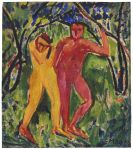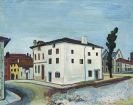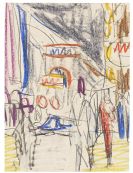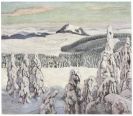
Wilhelm Morgner
Soest
1891 -
Langemarck
1917
Born in Soest, a small Westphalian town, Wilhelm Morgner at an early age lost his father. Since his mother expected him to become a clergyman, his artistic talents caused concern and were discouraged. On finishing school, however, he managed to assert his rights to pursue the career of his choice, enrolling in 1908 at a private painting school run by Georg Tappert in Worpswede. The work Wilhelm Morgner did in that early period was often highly realistic and frequently heavy and dark in mood. Tappert and Morgner became close friends during the brief year of training. Knowledgeable about the art scene, Tappert was able to pass on his experience to the younger Morgner, who had been working since 1909 as a freelance painter.
During this early phase from 1911, Wilhelm Morgner travelled frequently to Berlin, where he came into contact with the schools of art then prevailing such as Pointillism and Futurism. He was also confronted for the first time with the work of van Gogh and early Expressionism. All these new styles exerted a formative influence on his creative drive - he literally assimilated the knowledge thus gained.
Wilhelm Morgner's work was not long in meeting with acclaim. In 1911-13 he showed work at the Berlin "New Secessionist" and "Jury Free exhibitions" and in 1912 at the Cologne "Sonderbund exhibition". Magazines such as "Der Sturm", "Die Aktion" and the "Jahrbuch des Blauen Reiters" featured his work.
The artist was intensively preoccupied with pure colour. His pictures, which had previously dealt with working people in rural settings, became increasingly abstract - his efforts were now concentrated on conveying spiritual content. A clean break came in 1913, when Wilhelm Morgner was conscripted and sent to France, Poland and Serbia and only had drawing materials with him. He turned primarily to drawings dealing thematically with Eastern European and Near Eastern culture as well as religious motifs. Some of these sheets reveal Surreal traits. Like so many of his fellow artists, Wilhelm Morgner died far too young. He fell in the Langemarck in 1917. After his death his work was at first forgotten. It devolved upon Georg Tappert to grasp the significance of his work. Not until the 1950s, with the realisation that he was one of the best of his day, did Wilhelm Morgner's Oeuvre receive the recognition it deserved.
Would you like to sell a work by Wilhelm Morgner?
Infos for seller











